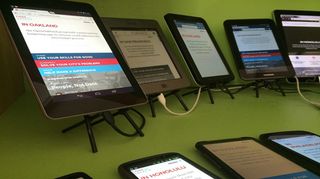When testing is the enemy of creativity
How to solve the problem of testing taking up important creative resources.
Why choose to make a living by creating apps and websites?
If you're a web designer or developer, you may well reply that the answer lies in the question itself – specifically, in the word 'creating'. Building software requires a shedload of creativity, innovation and problem solving, in order to deliver a product that will satisfy clients and provide a great user experience. All of which makes it a lot of fun, too.
But as with any job, the best parts of working at a digital agency sometimes have to take a backseat to other tasks. Software testing can be one such task. Vital to the quality of any agency's output, testing is fine when balanced with your primary, creative role. All too often, however, testing requirements may come to dominate, with disastrous results for creativity.
Bad timing
Part of this issue is time, a valuable commodity for any designer or developer. High workloads and tight deadlines mean that testing often isn't scheduled in between 9 and 5, which means it can become a stressful, though necessary, after-hours addition to your working day.
This can have two crucial effects on your work, your company, and your own well-being. One: the testing you do, hampered by your tiredness and desire to get out of the office, is likely to be ineffective. And two: when the extra hours start to pile up, the creativity of your design or development work is going to suffer.
But the worst consequence of testing in this way is that these effects can spiral out of control. Missing bugs because you're tired usually results in software coming back for post-go live fixes. This can take up even more of your time and make you more tired and stressed, which in turns leads to more missed bugs. Under these conditions, creativity can plummet.

This, you'll appreciate, is an ironic state of affairs. In these circumstances, rather than improving software quality as it is meant to do, testing can actually degrade the quality of your agency's apps and websites. The net result is that you become exhausted and enjoy work less, your clients become dissatisfied with what they receive, and your agency's profitability declines.
Get the Creative Bloq Newsletter
Daily design news, reviews, how-tos and more, as picked by the editors.
But if the quality of your software would suffer without testing, what can you do to escape this predicament? Isn't this a 'damned if you do and damned if you don't' scenario?
Testing times
Thankfully, there is an easy solution to this problem: unburden yourself by assigning testing to dedicated professionals. Having software testers check your work for bugs would immediately reduce your workload, enabling you to dedicate your energies to creative design or development work within the limits of the normal working day.
The quality of your software would improve as a result, as would the quality of your own day-to-day experience at work. Bug fixes could be done quickly and efficiently before deadlines, leading to greater client satisfaction and higher profits for your agency.
You may, at this point, be thinking of something which seems to be as much a perennial feature of agency life as long hours and high workloads: tight development budgets. Having software tested by professionals comes at a price, and it could be that there's little room for that price in an already stretched allocation of funds.
False economy
Unfortunately, this is undeniably true. Hiring testers will always represent an extra outgoing for your agency. However, that isn't to say that leaving testing to professionals always represents an added cost in absolute terms. Often, working with software testers can have the opposite effect: it can reduce overall development costs.
This is because poor testing that negatively impacts on your creativity can itself often lead to huge costs. These might take the form of lost business due to client dissatisfaction, or the taking up of your own time with post-go live fixes rather than development or design work.
This means that while having your software tested professionally does represent an extra outgoing, it can provide your agency with significant savings in the long run. Arguably, it can also increase profits by giving you more time to be creative and improving the quality of your output.
The size of your saving will depend on your approach to testing. Hiring full-time testers in-house, outsourcing to a traditional testing provider, and partnering with a crowdsourced testing company are the three main options, each representing a different level of expenditure. But the right approach for your budget could do wonders for your agency, your clients, and yourself.
Rather than being the enemy of creativity at digital agencies, testing should be its facilitator. The creation and testing of software share a common goal: namely, the delivery of high-quality software to satisfied clients. When testing is left to testers, meaning that designers and developers can focus on being creative, that goal can be achieved again and again.
Words: Martin Mudge
Image: "Device Lab" by Jeremy Keith is licensed under CC BY 2.0

Martin Mudge is founder and technical Director at BugFinders. Working in testing for over 15 years, he has headed up teams and corporates including Orange, Sophos and Nationwide. Frustrated with the need to test at high speed and with high coverage levels on web and mobile, he saw the opportunity that BugFinders could deliver and now delivers to clients such as Audi, WorldPay, Hilton Worldwide and Bang & Olufsen.
Like this? Read these!
- Web design training: The top online resources
- Underrated web design tools
- Photoshop web design: tips to make you more efficient

Thank you for reading 5 articles this month* Join now for unlimited access
Enjoy your first month for just £1 / $1 / €1
*Read 5 free articles per month without a subscription

Join now for unlimited access
Try first month for just £1 / $1 / €1
The Creative Bloq team is made up of a group of design fans, and has changed and evolved since Creative Bloq began back in 2012. The current website team consists of eight full-time members of staff: Editor Georgia Coggan, Deputy Editor Rosie Hilder, Ecommerce Editor Beren Neale, Senior News Editor Daniel Piper, Editor, Digital Art and 3D Ian Dean, Tech Reviews Editor Erlingur Einarsson, Ecommerce Writer Beth Nicholls and Staff Writer Natalie Fear, as well as a roster of freelancers from around the world. The ImagineFX magazine team also pitch in, ensuring that content from leading digital art publication ImagineFX is represented on Creative Bloq.
